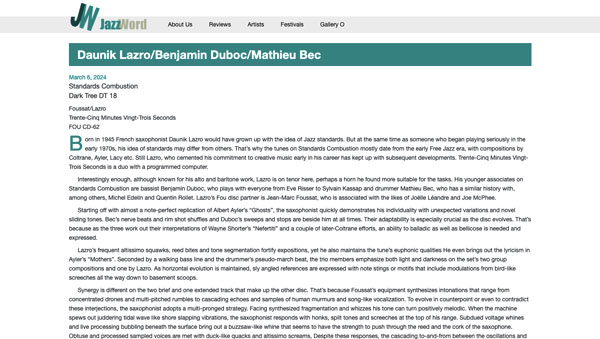• Ken Waxman // JazzWord (March 6, 2024)
Standards Combustion
Dark Tree DT 18
Foussat/Lazro
Trente-Cinq Minutes Vingt-Trois Seconds
FOU CD-62
Born in 1945 French saxophonist Daunik Lazro would have grown up with the idea of Jazz standards. But at the same time as someone who began playing seriously in the early 1970s, his idea of standards may differ from others. That’s why the tunes on Standards Combustion mostly date from the early Free Jazz era, with compositions by Coltrane, Ayler, Lacy etc. Still Lazro, who cemented his commitment to creative music early in his career has kept up with subsequent developments. Trente-Cinq Minutes Vingt-Trois Seconds is a duo with a programmed computer.
Interestingly enough, although known for his alto and baritone work, Lazro is on tenor here, perhaps a horn he found more suitable for the tasks. His younger associates on Standards Combustion are bassist Benjamin Duboc, who plays with everyone from Eve Risser to Sylvain Kassap and drummer Mathieu Bec, who has a similar history with, among others, Michel Edelin and Quentin Rollet. Lazro’s Fou disc partner is Jean-Marc Foussat, who is associated with the likes of Joëlle Léandre and Joe McPhee.
Starting off with almost a note-perfect replication of Albert Ayler’s “Ghosts”, the saxophonist quickly demonstrates his individuality with unexpected variations and novel sliding tones. Bec’s nerve beats and rim shot shuffles and Duboc’s sweeps and stops are beside him at all times. Their adaptability is especially crucial as the disc evolves. That’s because as the three work out their interpretations of Wayne Shorter’s “Nefertiti” and a couple of later-Coltrane efforts, an ability to balladic as well as bellicose is needed and expressed.
Lazro’s frequent altissimo squawks, reed bites and tone segmentation fortify expositions, yet he also maintains the tune’s euphonic qualities He even brings out the lyricism in Ayler’s “Mothers”. Seconded by a walking bass line and the drummer’s pseudo-march beat, the trio members emphasize both light and darkness on the set’s two group compositions and one by Lazro. As horizontal evolution is maintained, sly angled references are expressed with note stings or motifs that include modulations from bird-like screeches all the way down to basement scoops.
Synergy is different on the two brief and one extended track that make up the other disc. That’s because Foussat’s equipment synthesizes intonations that range from concentrated drones and multi-pitched rumbles to cascading echoes and samples of human murmurs and song-like vocalization. To evolve in counterpoint or even to contradict these interjections, the saxophonist adopts a multi-pronged strategy. Facing synthesized fragmentation and whizzes his tone can turn positively melodic. When the machine spews out juddering tidal wave like shore slapping vibrations, the saxophonist responds with honks, split tones and screeches at the top of his range. Subdued voltage whines and live processing bubbling beneath the surface bring out a buzzsaw-like whine that seems to have the strength to push through the reed and the cork of the saxophone. Obtuse and processed sampled voices are met with duck-like quacks and altissimo screams, Despite these responses, the cascading to-and-from between the oscillations and the acoustic output is fascinating as it’s constantly shifting and it’s mobile enough to highlight meaningful textures from both players.
Showing that past sounds can be reinterpreted inventively and connecting with contemporary tone currents with the same skill and determination, Lazro confirms his unabated musical accomplishment as he heads towards his 80th birthday.
• • • • • • • • • • • • • • • • • • • • • • • • • • • • • • • • • • • • • • • • • • • • • • • • • • • • • • • • • • • • • • • •

Sorry, the comment form is closed at this time.